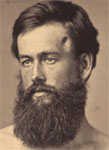 Open main menu
Open main menu
 Open main menu
Open main menu

E.D. Bemis
(1841 - 1900)
Home State: Massachusetts
Command Billet: Soldier
Branch of Service: Infantry
Before Antietam
A 21 year old farmer from Middlefield, he enlisted in Company I of the 15th Massachusetts Infantry on 5 December 1861.
On the Campaign
He was wounded at Antietam by a musket ball which fractured the shaft of his left humerus [upper arm bone]. The fracture united kindly with very slight angular displacement and of an inch shortening.
The rest of the War
He reenlisted in the 15th on February 1864, by May he was promoted to Corporal.
Bemis received May 6th 1864 at the battle of the Wilderness a wound from a musket ball in the right iliac fossa [hip/pelvis]. He was treated in the Chester Hospital near Philadelphia. There was extensive sloughing about the wound but it ultimately healed entirely leaving a large cicatrix parallel with Poupart a ligament.On 12 July 1864 he transferred to Company K of the 20th Massachusetts.
On February 5th 1865 Corporal Bemis was again severely wounded at the engagement at Hatcher's Run near Petersburg Virginia Surgeon A Vanderveer 66th New York Volunteers reports that the ball entered a little outside of the left frontal protuberance [temple] and passing backward and upward removed a piece of the squamous portion of the temporal bone with brain substance and membranes. When the patient entered the hospital - the 1st division of the Second Corps - brain matter was oozing from the wound. There was considerable hemorrhage but not from any important vessel. Respiration was slow, the pulse 40, the right side was paralyzed, and there was total insensibility. On February 8th the missile was removed from the substance of the left hemisphere by Surgeon Vanderveer. It was a colloidal musket ball badly battered. The patient's condition at once improved. He told the surgeon his name and seemed conscious of all that was going on about him. Water dressings were applied and an ingeniously arranged sponge absorbed the discharge from the wound. He was kept on very light diet and remained very quiet for ten days answering direct questions but indisposed to continue a conversation. He had no convulsions and his sleep was not disturbed by delirium.
About February 18th a marked improvement was manifest. The patient conversed freely and the wound was rapidly cicatrizing and the hemiplegia had entirely disappeared. On February 23rd he was able to walk about the ward. On March 18th the wound was nearly healed. The patient was sent northward on a hospital transport to Fort Richmond, New York Harbor. He recovered perfectly and in May was furloughed, and on May 18th he wrote to Dr Vanderveer that he was doing well at his home in Huntington, Massachusetts suffering only slight dizziness in going out in the hot sun In July.
He went to Washington to apply for a pension and entered Campbell Hospital. He was discharged on July 13th 1865 on surgeon's certificate of disability. At this date he was photographed at the Army Medical Museum. The wound in the head was then nearly healed. There was a slight discharge of healthy pus from one point. The pulsations of the brain could be felt through the integument. The mental and sensory faculties were unimpaired. The corporal had been discharged from service and recommended for a pension.
After the War
Bemis received an initial pension of 8 dollars a month. On 30 October 1870 he wrote to the editor of the surgical history from his home in Suffield, Connecticut as follows
I am still in the land of the living. My health is very good considering what I have passed through at Hatcher's Run. My head aches some of the time. I am married and have one child, a little girl born last Christmas. My memory is affected and I cannot hear as well as I could before I was wounded.He worked as a laborer for at least 15 years, but his health began to deteriorate - with dizzy spells and other symptoms relating to his head wound. In 1890 he had a "severe Paralytic Shock" and became nearly totally dependent on his wife for care. By April 1900 his faculties were gone, and he was slated for an Asylum, but his sister took him to her farm in Massachusetts for care until his death.
References & notes
Medical details quoted from the Medical and Surgical History1, which is also the source of an 1865 photograph showing his many wound scars - part of which is used at the top of this page. Post-War details from research in pension files by Archivists Rebecca K. Sharp and Nancy L. Wing in Prologue (Spring 2011, Vol. 44, No. 1),
Both sources above list Bemis in the 12th Massachusetts, but Soldiers2 details his service in the 15th (Co. I) and 20th (Co. K) Regiments. Further details and life dates from the excellent Roster complied by Susan Harnwell.
Birth
04/06/1841; North Chester, MA
Death
11/09/1900; North Brookfield, MA; burial in Old Center Cemetery, Suffield, CT
1 Barnes, Joseph K., and US Army, Office of the Surgeon General, The Medical and Surgical History of the War of the Rebellion, 6 books, Washington DC: US Government Printing Office, 1870-1883, Part 1, Volume 2, pg. 162 [AotW citation 1229]
2 Commonwealth of Massachusetts, Adjutant General, Massachusetts Soldiers, Sailors, and Marines in the Civil War, 8 Vols, Norwood (MA): Norwood Press, 1931-35, Vol. 2, pp. 190, 577 [AotW citation 1230]